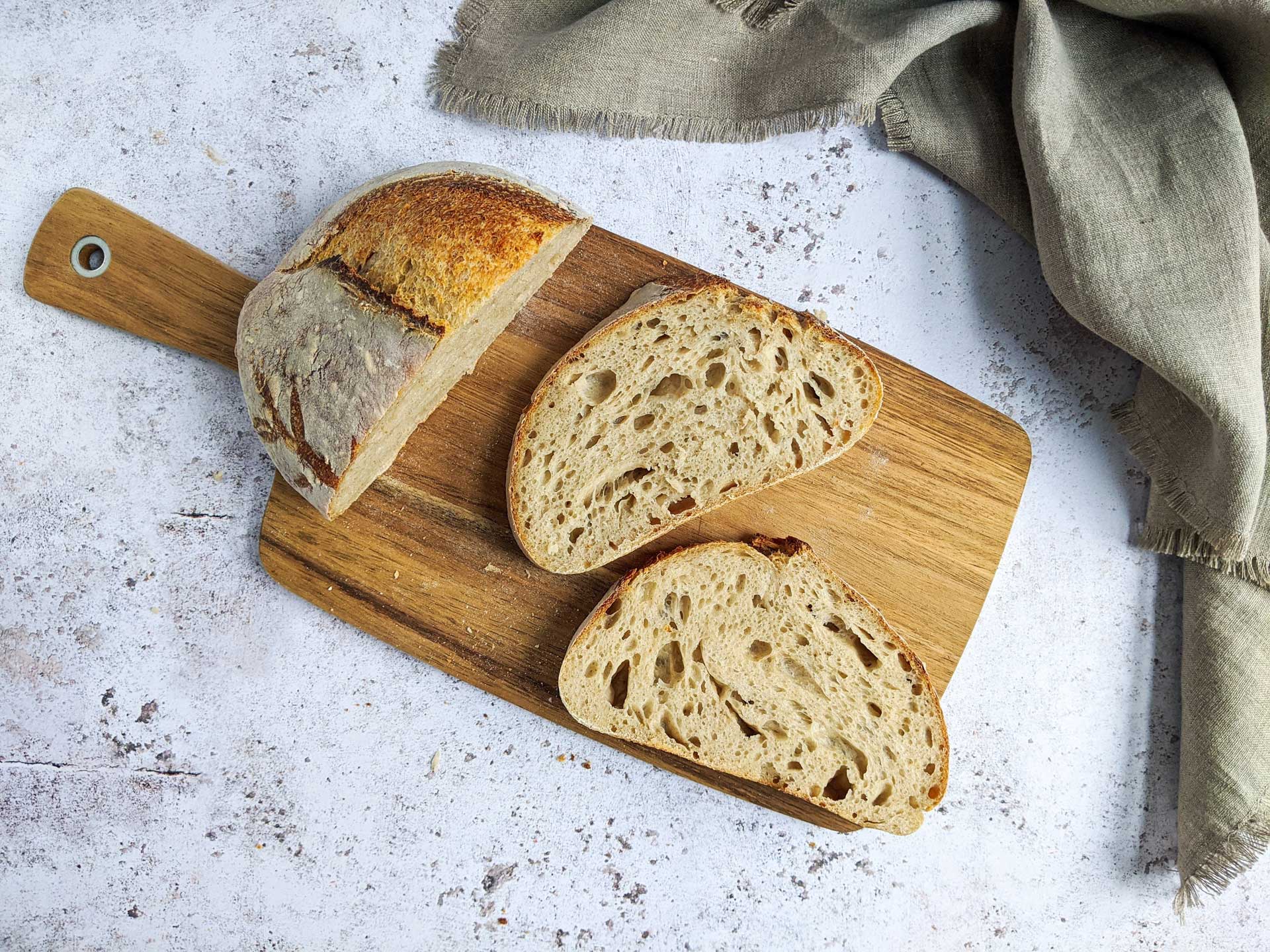The artisan bakery has regained strength, currently becoming a boom, which is why the famous sourdough is also taking center stage. Preparing your own natural yeast or sourdough at home is an unforgettable practice, both for the result and for the experience itself. Yes, many bakers, amateurs or professionals, are committed to a return to culinary purism. For this reason, we invite you to discover, together everything about this ferment and live your own culinary experience cultivating it. I’m sure you’ll love it!

Discover with us what it is and how to make homemade sourdough, quickly, easily and with spectacular results.
What is sourdough?
Sourdough is fermented dough, prepared from water and any type of flour. That is to say, it is aged dough with the intention of using it as natural yeast. The elaboration of this ferment is artisanal and consists of the cultivation of microorganisms (fungi), present in the air and in the natural yeast of the food, sustaining them from the sugars that the flours contain.
The duration of this yeast is infinite (it lasts even centuries); everything depends on the care you give it, thus being able to endure many generations in your family. Can you imagine it? Said to have originated in the time of the Egyptians, this ancient practice can certainly become your family culinary legacy.
Mother dough: traditional recipe
To prepare sourdough for bread, always use whole meal flour (be it wheat, rye, spelled, etc.), alone or combined with another flour that is refined (wheat, rye, etc.). The use of a whole product favors the cultivation of microorganisms, unlike refined products. That said; let’s go with the recipe to discover how natural and traditional sourdough is made:
Ingredients to make sourdough
- 200 g of wheat flour
- 200g whole rye flour
- 400 soft or bottled water (at room temperature, not hot or cold)
- A very clean jar (better yet sterilized)
Steps to make natural sourdough (for 5 days)
Day 1: to start you need:
- 25 g of wheat flour
- 25g whole rye flour
- 50g soft or bottled water
- 1 sterilized jar
Inside the jar, mix all the ingredients and then cover it with a clean canvas or cloth, whose texture allows air to circulate. Natural yeast only needs warm or warm temperature, oxygen and sugars (which come from the flour) to reproduce. Let the mixture ferment for 24-36 hours, after that time you can start with the next step.
Day 2: add the same ingredients as the day before and the same amounts to the reserved preparation. Ferment again for another 24 hours. At this point, you can already detect certain sensory characteristics of the ferment: acid aroma and some small holes (alveoli). We are making progress!
Day 3: continue using the same ingredients but doubling the amount, looking likes this:
- 50 g of wheat flour
- 50g whole rye flour
- 100g soft or bottled water
Before adding them to the dough, remove half of the mixture contained in the jar. Cover it again and wait another 24 hours.
Day 4: repeat the entire process of the previous day. By this time, you will notice a more intense aroma and an accelerated increase in the volume of the preparation. Rest the mixture for another 24 hours.
Day 5: Again, perform the above procedure. 24 more hours and you will have your natural yeast!
Day 6: the sourdough will have already doubled its volume, even more, so that it will be ready to be used.
This is the sourdough for traditional bread, easy to make and with which you can make fluffy and delicious breads. With this same recipe you can make spelled sourdough, since you would only need to replace the rye flour with spelled flour. Once ready, do not miss these recipes:
- Sourdough bread
- Rye bread with sourdough
- Ciabatta bread with sourdough
Tip: Every time you feed the sourdough, stir.
How to make quick sourdough?
Is there a quick and easy sourdough recipe? Yes, although the traditional preparation is not difficult, there is an even simpler way. Thanks to this recipe, you will have natural sourdough in just 2 days! Take note to know how to make sourdough at home in this faster and easier way:
Ingredients
- 1 liter of water
- 2 kg of wheat flour
- 300 g of rye flour
- 20g of honey
Steps to make quick sourdough
- Pour half of the all-purpose wheat flour (1 kilo) into a large container and reserve the rest (1 kilo).
- Make a hole in the center (volcano type) and then add the rye flour, honey and half the water, that is, ½ liter (reserve the rest of the liquid).
- Knead until you get a homogeneous texture (smooth and smooth).
- Cover the sourdough and let it rest for 48 hours in a warm place.
After time, incorporate the reserved ingredients into the sourdough or ferment (natural yeast) already rested. Knead again for a few minutes, until it forms a ball. You can now use the sourdough!
How to make gluten free sourdough?
Yes, there is also gluten-free sourdough. The procedure is very similar to that used for traditional natural yeast, only the flour changes, which in this case we will use rice flour. With that said, let’s get started!
Ingredients
- 110 g of water preferably mineral or filtered
- 110g brown rice flour (preferably organic)
- 1 very clean glass jar (better sterilized)
Steps to make gluten-free sourdough
Day 1: To start the first day, you need:
- 50 g of brown rice flour
- 50g soft or bottled water
Pour the ingredients into the glass jar and mix them very well. Mark the jar indicating how far the mixture reaches to have a reference. Leave the preparation to rest for 24 hours at room temperature and covered with a cloth. Remember that the mixture grows best in warm environments, so place the jar in a warm spot.
Day 2: just remove the preparation and let it rest one more day, also at room temperature and covered. On this day, the first bubbles should appear, however, everything will depend on the temperature of the place where you live.
Day 3: Add 25 grams of brown rice plus 25 grams of water. Since you started out using a small amount of flour and water, don’t remove anything this day. Let stand, in the same conditions as the day before, for another 24 hours.
Day 4: You can already observe certain characteristics in the sourdough: a bubble, a smell that resembles strong cheese and it has doubled its volume. At this point, you should remove some of the mixture until you reach the same portion of day one. Then add 25 grams of the whole wheat flour plus 25 grams of water. You will see how the ferment grows and spreads rapidly, as its rate of reproduction speeds up. Cover it again and let the gluten-free sourdough rest for another day.
Day 5: Add 10 grams of brown rice flour and 10 grams of water to the mix. Wait a couple more hours, or until the sourdough rises quite a bit and looks bubbly. Once you observe these characteristics, you can now use your natural gluten-free yeast.
Remember:
- Always leave around 50 grams of natural sourdough in the jar for future preparations.
- Store the ferment in the fridge until you need it again and feed it weekly.
Tip: Every time you feed the sourdough, stir.
Benefits of homemade sourdough
Now that you know how to make sourdough for traditional bread, quick sourdough and gluten-free sourdough, the most common types of sourdough, the time has come to learn about its uses and benefits. Currently, many professional bakers or kitchen lovers have returned to the use of sourdough for the magnificent benefits it provides, both in the kitchen and in the body. Do you want to know what those attributes are? Here are the highlights:
- Improves the organoleptic qualities of bread(aroma, texture, size, smell, color and others). In other words, it provides a moister and fluffier crumb, a crispier and darker crust, and a unique flavor and aroma.
- Preserves the nutrients of the bread. Bread prepared with sourdough requires a low temperature for baking, which is why it requires a longer baking time and, consequently, conserves a large part of its nutrients.
- Extends the durability of the final product. Breads made with sourdough don’t get hard or moldy as quickly and retain their flavor longer. This type of bread can last up to 5 days in good conditions if you store it properly.
- Contains no chemical additives and requires few ingredients. Definitely a return to purist and naturist cuisine, which implies a healthier diet.
- It makes bread a more digestible fooddue to two factors: the fermentation process and the longer baking time. On the one hand, during baking, gluten and physic acid are reduced, making the bread more assailable for the body. On the other hand, the microorganisms produced during fermentation favor the intestine.
- It is healthier. Bread prepared with sourdough does not require the use of fat, which is why it is lighter.
- It favors diabetic people. Sourdough bread has a lower glycemic index than yeast-based bread.
- Each bread acquires personality. It is said that there are around 200 possible aromatic notes, both in the crust and in the crumb, when you use this natural ferment. Each sourdough has its own personality, as there are variables that arise in the preparation process that give it particular characteristics.
- Provides a high quality end product. Yes, artisanal bread often far exceeds commercial products, due to all the points made above.
How to preserve the sourdough once made?
Once you have your natural sourdough made, you must preserve it properly to be able to feed it every time you use it and keep it that way for many years. If you are a person who loves to prepare homemade bread and, therefore, you are going to use your sourdough on a daily basis, it is best to reserve the jar with the ferment inside in a place free of moisture and at room temperature. Now, if you plan to use the sourdough from time to time, it is best to keep it well covered in the refrigerator.
In the second case, you will have to remove the sourdough from the fridge one or two hours before preparing the bread to get it to reach room temperature.
On the other hand, keep in mind that you must feed the sourdough every week, even if you don’t use it, to keep it alive and in perfect condition.



